

The impetus for our Hawaii trip was the desire to take one last vacation with the two of us before the arrival of our first child a few months later. We had previously scheduled a trip to Japan which had to be canceled as COVID restrictions prevented us from entering the country. Hawaii was the runner-up location in terms of places that we were most interested in visiting and it looked to be an ideal place to spend two weeks on our "babymoon" vacation. Liz had taken a trip to Maui almost two decades earlier while I had never visited the islands at all; as a result, we decided that we would travel to Oahu and the big island of Hawaii in order to see places that neither of us had experienced previously. We scheduled our vacation for the end of June and the beginning of July despite the high cost of traveling to Hawaii in the summer since any further delays would bring us too close to our upcoming due date in September.
Hawaii is a long distance away from our home in the Washington DC region and we ended up needing two flights to make our way there. We had the time zones working in our favor as we headed westwards, flying out of Washington DC at the reasonable time of 10:00 AM on a Saturday morning and arriving in Phoenix after a five hour flight that took less than two hours according to the clock. We were concerned about flight delays after having some terrible experiences on recent trips and needing to make a connecting flight in Phoenix but for once everything was running on time smoothly. We grabbed a meal that was some combination of lunch and dinner at the Phoenix airport and then embarked on a six hour flight to Honolulu. This plane ride was noteworthy because we were trying to reserve online tickets to the USS Arizona Memorial at Pearl Harbor for the next day, tickets that only became available starting at 3:00 PM (Hawaii time) the day before. We happened to be flying over the eastern Pacific when the time arrived only to discover that the in-flight Wifi didn't work that far out at sea. It was understandable given our situation but still disappointing. We'd have to find some other way to get tickets to this attraction.

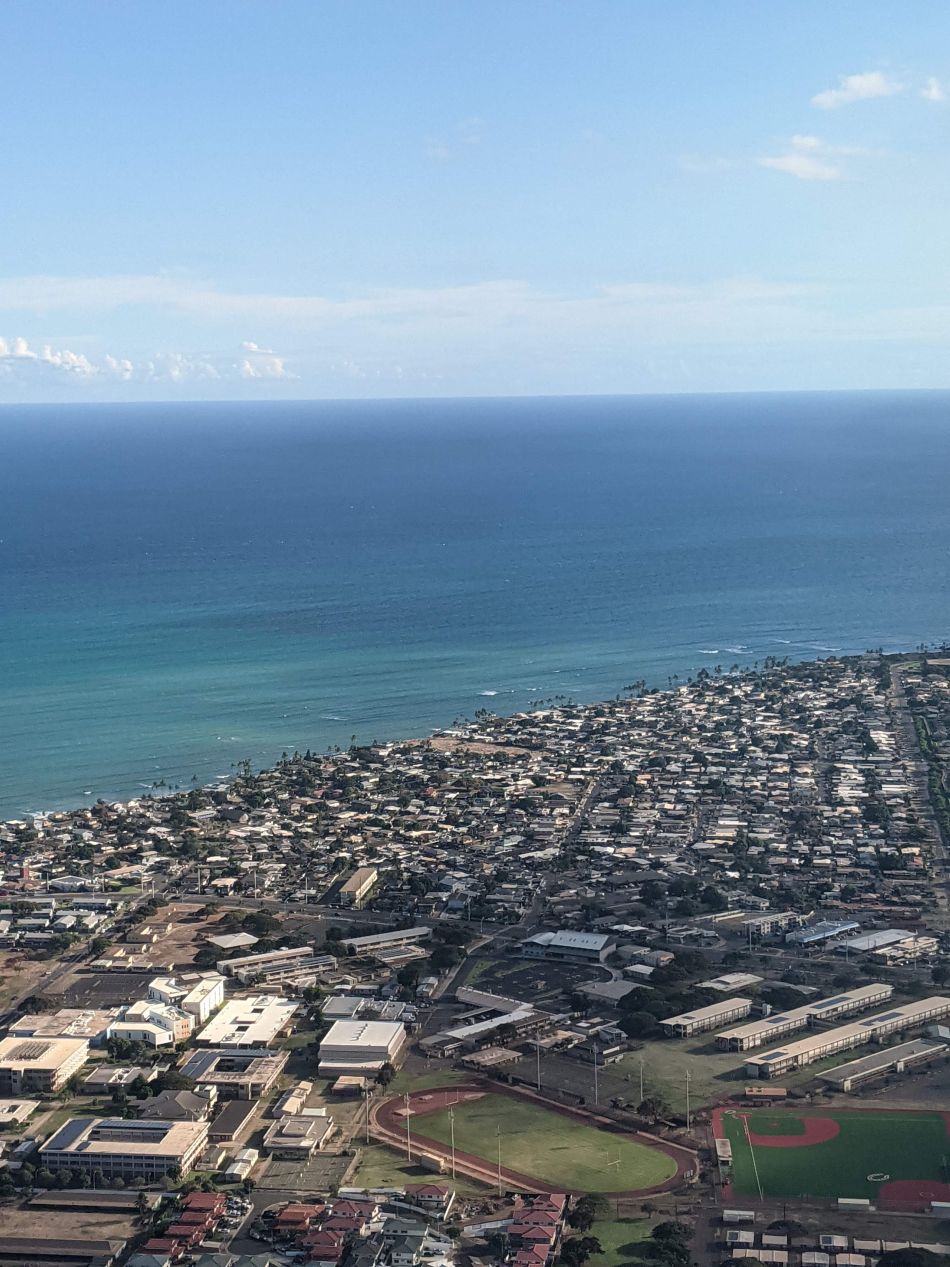


Our plane began descending outside Honolulu right on schedule around 5:30 PM local time, six hours offset on the clock from where we had started that morning. Liz snapped some pictures of the beautiful local scenery as the plane landed at the main airport a short distance to the west of Honolulu's downtown. We picked up our bags and caught a ride to our hotel over in Waikiki where we would be staying for the next week. For the moment, we didn't have a rental car and would have to rely on local transportation. We were very tired at this point given the time zone differences and couldn't do much more than eat another small meal followed by going to sleep in our hotel room. I think that we both made it to roughly 9:00 PM which was more like 3:00 AM for the two of us. I'm lucky enough to adjust to time zone changes quickly but it always takes Liz some time to adapt when flying a quarter of the way around the globe.

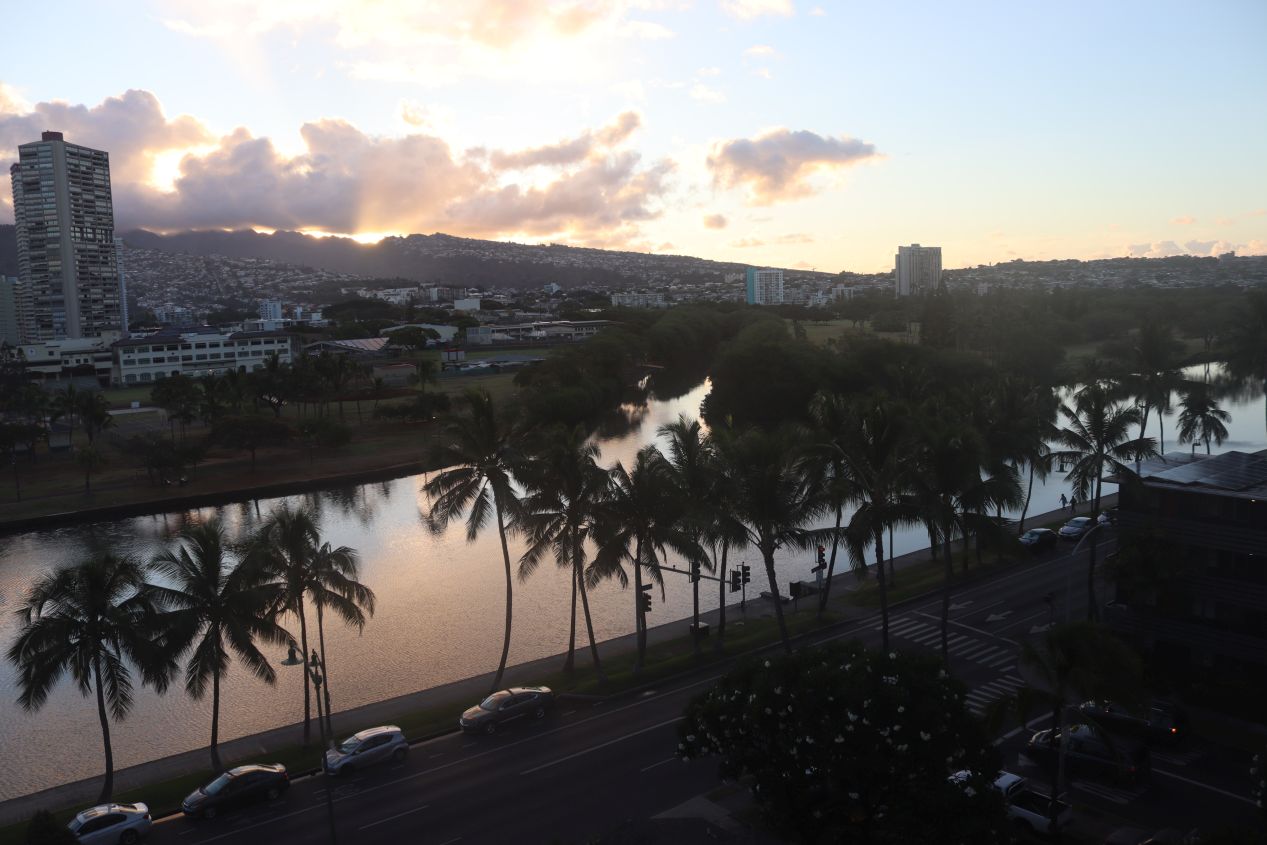


With that in mind, it should come as no surprise that we both woke up very early the next morning at about 5:30 AM Hawaii time. This was right when the sun was starting to rise over the eastern edge of Oahu and we were able to capture some lovely views from the little balcony attached to our hotel room. We had decided that we'd use this first day on Oahu to visit Pearl Harbor and the various memorials located there which fortunately opened to the public at the early time of 7:00 AM. First we needed to get some breakfast and we strolled around the deserted streets of Waikiki for a little bit trying to get a better sense for the area. We were staying a few blocks away from the beach in Waikiki (which lowered the price of the hotel room substantially) and passed by a good number of joggers and other tourists who were equally jet-lagged with time zone wackiness. Eventually we found the pictured Island Vintage Coffee store where we were able to get some breakfast and then use a ride-sharing application to hail a car for the roughly 10 mile / 16 kilometer trip over to Pearl Harbor itself.

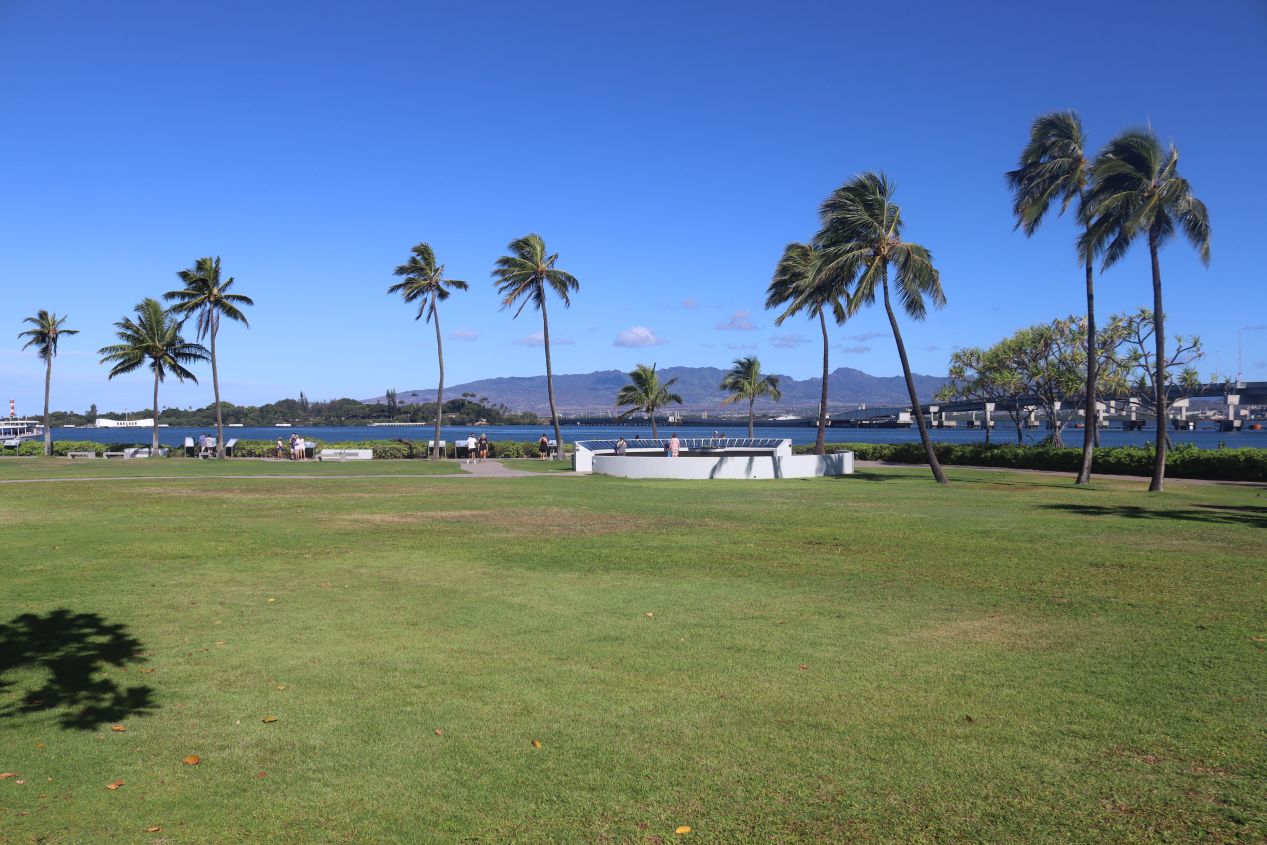


It was shaping up to be a typically gorgeous sunny day on Oahu as we arrived at Pearl Harbor around 7:30 AM. Pearl Harbor was recognized as an excellent deep-water harbor as early as the 1820s and was highly prized by the United States for use as a naval base; control of Pearl Harbor's strategic location was a major motivation for the American-backed overthrow of Hawaii's native government in 1893. Pearl Harbor is still in use as a naval base today and it remains the headquarters for the United States Pacific Fleet. The location is best known for being the site of a surprise attack by the Imperial Japanese Navy on 7 December 1941 which prompted American entry into World War II. Pearl Harbor was one of my most-desired locations to visit after reading so much about the history of the attack since there are always lots of details that you can only pick up by seeing places firsthand.
Entry to Pearl Harbor National Memorial itself was free although visiting most of the attractions within the memorial grounds required a fee. Even at 7:30 AM on a Sunday morning it was already starting to get crowded at Pearl Harbor, with other visitors streaming into the memorial area and tour buses beginning to pull up. Our early arrival was fortuitous since we were able to get in the standby line for the USS Arizona Memorial along with everyone else who lacked reserved tickets. This was what we had tried to obtain on the plane ride the day before and been unable to secure; the online tickets can only be claimed 24 hours in advance or 60 days in advance and they always get snapped up in minutes. There were something like 200-300 people ahead of us in the standby line and we decided to alternate with one of us standing in line while the other person walked around exploring the grounds. These were some of the pictures that I took while Liz was holding down our spot in that long line (which I really should have photographed).
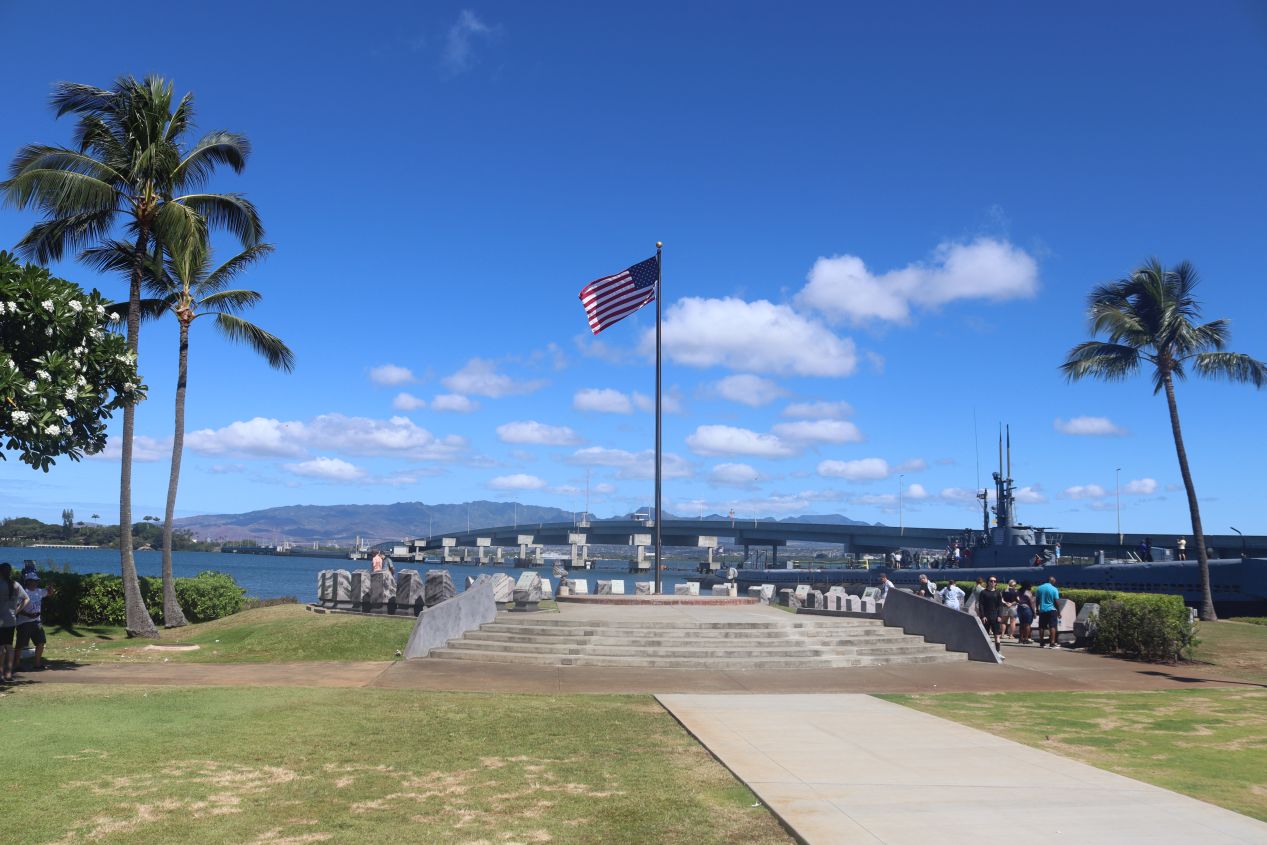
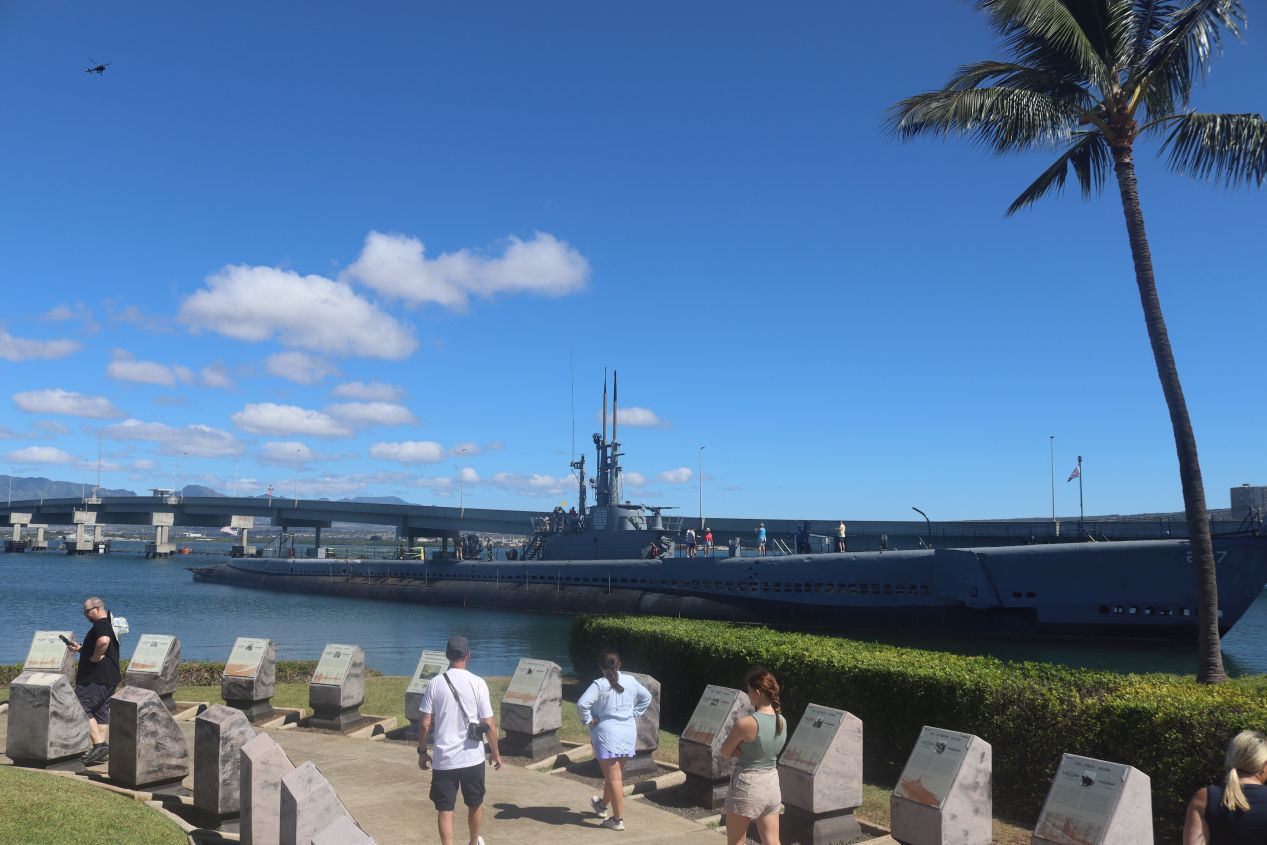


Pearl Harbor National Memorial is located a little bit to the north of the main naval base where there's a clear view across the harbor to tiny Ford Island in the middle of the water. That was where all of the battleships comprising the core of the United States Pacific Fleet were docked at the time of the Japanese attack, lined up neatly in rows where they were easy targets for dive bombers. For modern-day visitors to Pearl Harbor, the biggest attraction is the memorial constructed atop the sunken remains of the USS Arizona which we would be experiencing as soon as we could get to the front of the standby line. There's also the USS Missouri to visit, a World War II era battleship that wasn't destroyed in the attack, along with the Pearl Harbor Aviation Museum and the submarine named the USS Bowfin. We'd be visiting everything except the submarine so I tried to capture a few pictures of the Bowfin as I strolled around the visitor grounds. The US military had done a wonderful job of putting together these memorials which are solemn reminders of the people who died here situated in one of the most beautiful locations I've ever visited.

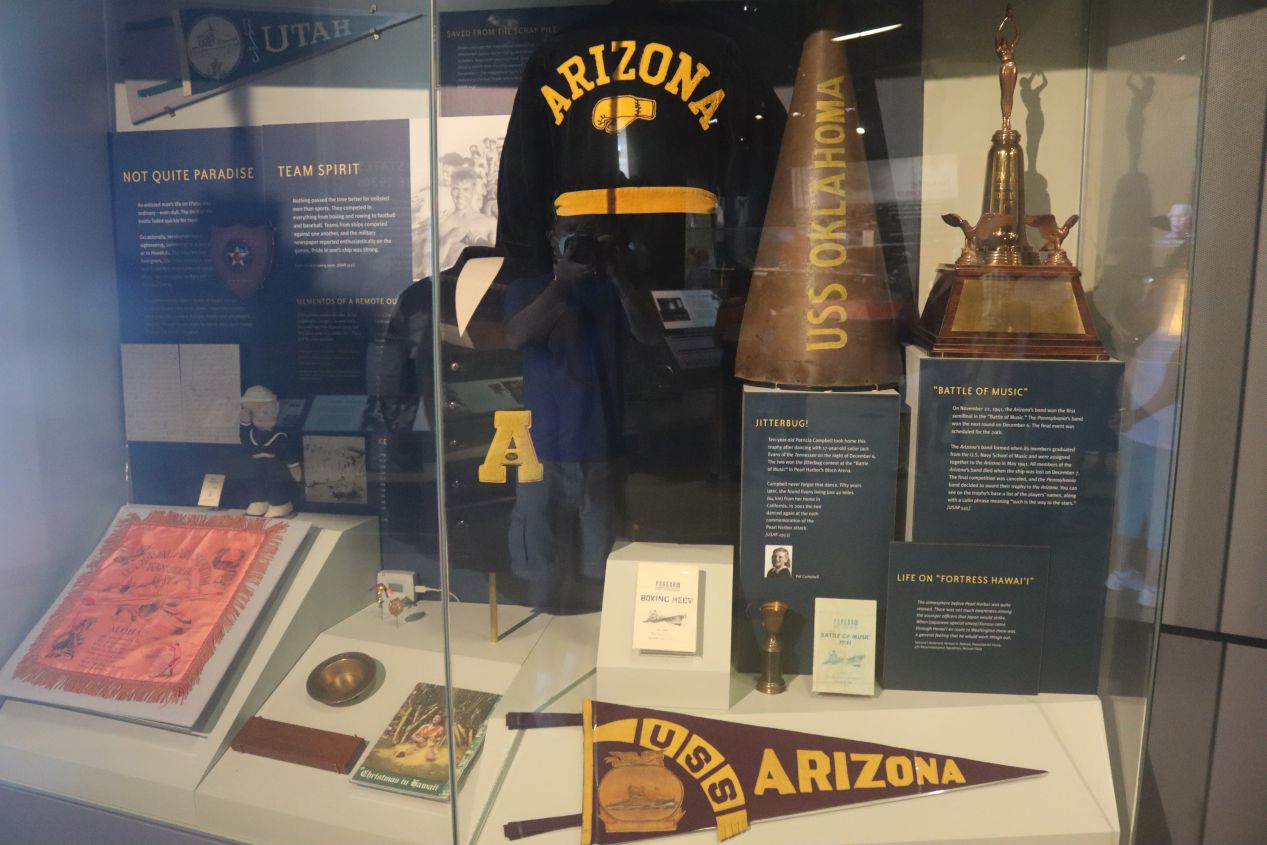


There's a small museum at Pearl Harbor that takes visitors through the chronology leading up to the 1941 attack and showcases some of the artifacts recovered from the sunken ships. I was very familiar with the background leading up to the Japanese attack, with Japan's military leadership calculating that they could do enough damage with an initial surprise attack to free up their fleet to overrun Southeast Asia and then hopefully sue for peace before getting sucked into a protracted war. The attack was a tactical success but a strategic failure, sinking more battleships than the Japanese could have hoped but hardening American public opinion to fight back in the lengthy conflict that the Japanese knew they could never win. Unfortunately for Japan, it also turned out that battleships were not particularly important any longer and aircraft carriers had become the key ships in naval warfare; by pure chance the American carriers were not present in Pearl Harbor when the attack took place. The museum had lots of maps and scale models of the ships to help provide context on the events that took place. There was also a gift shop selling all kinds of souvenirs associated with Pearl Harbor which unsurprisingly tended to be nationalistic and pro-military. That was probably inevitable given this location. There was even some Hello Kitty merchandise with Pearl Harbor branding in what had to be one of the weirdest cross-promotions that I can recall.




I was worried that we might be stuck in the standby tickets line all day but it ended up moving faster than expected. The USS Arizona Memorial is located over the submerged wreck of the ship and visitors can only reach it by boat, with the ferries leaving every 30 minutes and carrying a strict limit of 200 people apiece. We kept moving up in the standby line on those half hour intervals and caught a big break when there was a huge flood of standby passengers allowed onto one of the boat trips; it looked like a tour bus had failed to arrive for its reserved slot and thus a ton of the standby visitors claimed their spots. All told, we stood in line for a little bit less than three hours before making the 10:30 AM boat trip out to the memorial. This wasn't too bad since we had been able to alternate holding our spot while walking around the rest of the memorial grounds but it wasn't exactly a short wait either. I would highly recommend reserving tickets online if possible (ideally 60 days in advance) or else arriving right when Pearl Harbor opens at 7:00 AM to claim a spot in the standby line. We showed up half an hour after opening and wound up with the aforementioned three hour wait.
It was all worth it though since a visit to Pearl Harbor without seeing the USS Arizona Memorial would have been a massive disappointment. Most visitors watch a 20 minute documentary film before heading out to the memorial which we weren't able to see due to our status as standby passengers. Instead we proceeded directly onto the boat operated by US Navy sailors that took us out to the floating memorial. It was a short trip across the waters of the harbor during which we were able to enjoy some excellent views of the ships and military installations that are still in use at Pearl Harbor. The rectangular white shape of the USS Arizona Memorial drew steadily closer as we approached its resting place just offshore Ford Island. (FYI: photography is not permitted when approaching the memorial, only when leaving it, and these pictures were actually taken during our departure.)

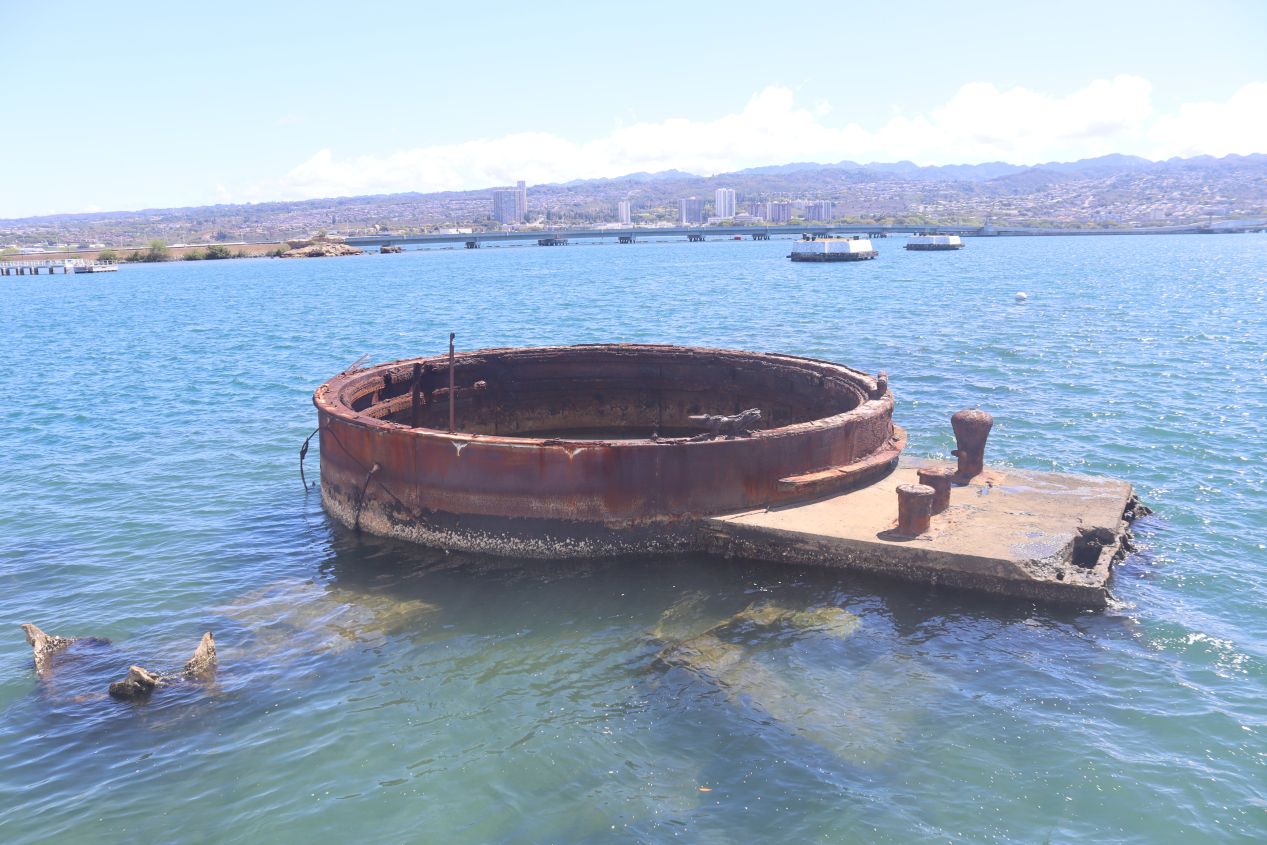


The USS Arizona Memorial proved to be quite crowded between the 200 tourists who had arrived on our boat and the previous group of 200 tourists from half an hour earlier who were about to make the return trip. Now it made sense why access to the memorial was strictly limited with the online registration system: there simply isn't enough room to accomodate more visitors. The bulk of the memorial was open to the sky above and held seven large windows on each side looking out over the rest of the harbor. I took a picture of the diagram showing the location of the memorial in reference to the remains of the Arizona; the rectangle runs perpendicular to the ship's positioning with only the remnants of the gun turrets and part of a funnel smokestack cresting above the waters. The memorial was formally opened to the public back in 1962 and more than a million people visit annually; we knew from our own experience getting tickets that this was by far the most popular attraction at Pearl Harbor.

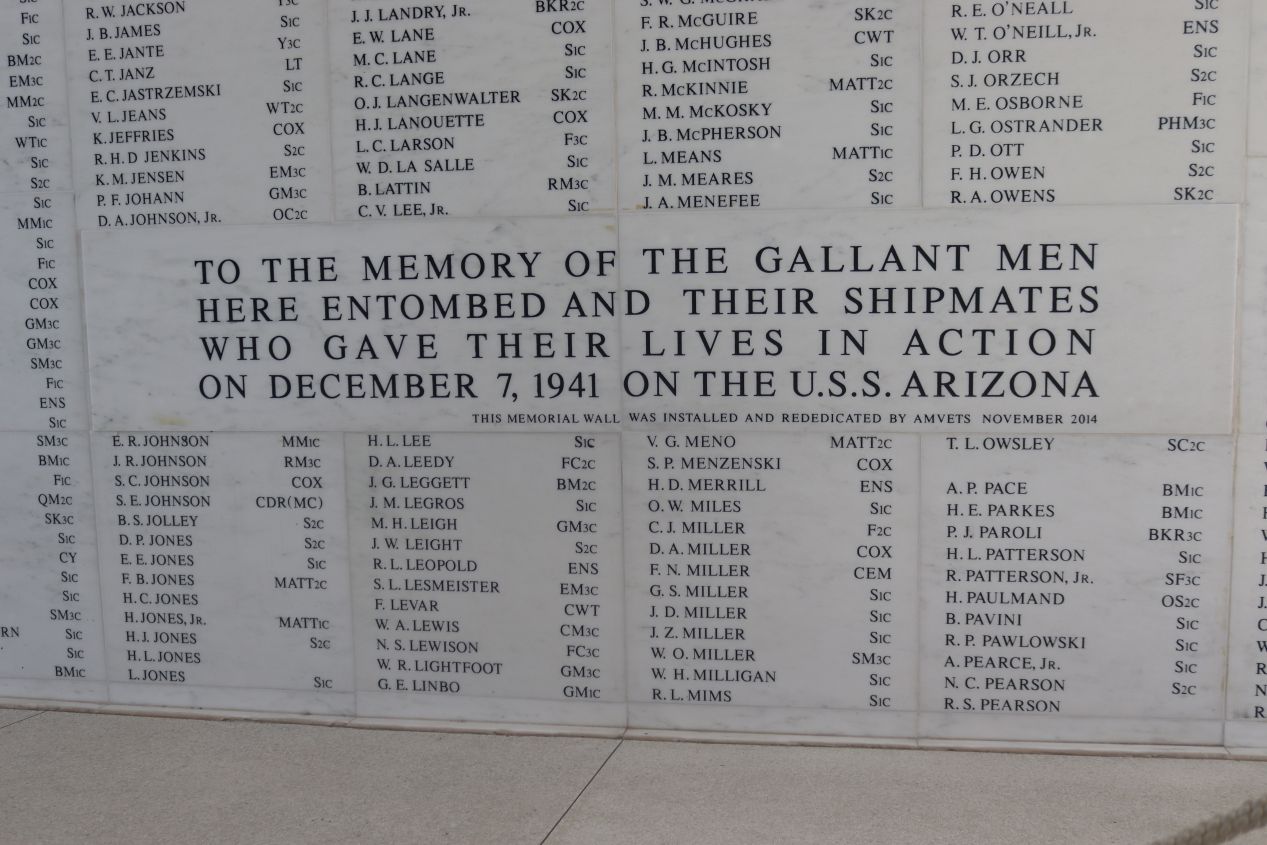


The back end of the memorial holds the shrine room listing the names of the 1177 sailors and marines who were killed when the Arizona sank during the Japanese attack. One of the bombs hit the forward magazines and immediately triggered a cataclysmic explosion that tore the ship apart and killed nearly 80% of its crewmembers. While the other battleships sunk at Pearl Harbor were eventually repaired and returned to service, the Arizona was too badly damaged to be recovered and thus it has remained in this spot ever since, deliberately left as a memorial to commemorate the deceased. We learned here that survivors of the attack on the Arizona have the option to place their final remains here after they die and several dozen have done so, with their names added to a separate smaller plaque at the memorial. This is considered to be an active military cemetery and everyone was treating it with appropriate respect on our visit.


Not far away from the USS Arizona Memorial sits its sister ship the USS Missouri, another battleship that was launched in 1944 after the attack on Pearl Harbor and has since been converted into a floating museum in its own right. The formal Japanese surrender that ended World War II took place on the decks of the Missouri and these two ships have been placed next to one another to symbolize the beginning and ending of the conflict (from an American perspective at least). I had heard that oil is still slowly leaking from the wreck of the Arizona and sure enough we spotted occasional dark spots floating up to the surface before being washed away by the local currents. Even though this is somewhat of an environmental hazard, the amount of oil leaking into the water is minimal and the US military has been adamant that they do not want the Arizona's wreck cleaned up so that it can remain in its undisturbed state. The drops of oil leaking from the ship have often been referred to as "the tears of the Arizona" and the symbolism couldn't be more apparent. It really does appear as if the broken remnants of the ship are mourning its fallen crewmembers with this trickle of inky tears.

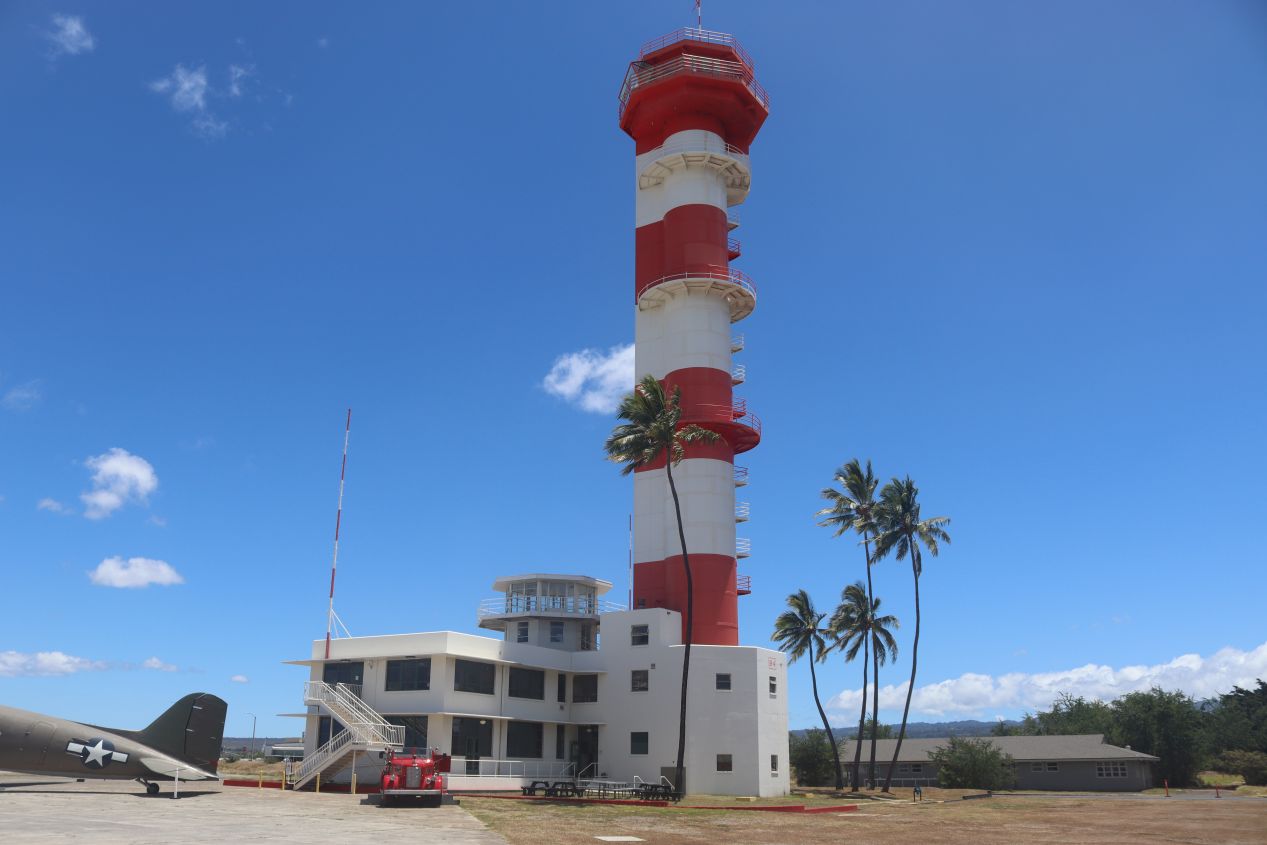


The ferry boats arrive at the USS Arizona Memorial every 30 minutes with military precision and that proved to be just about the right amount of time to spend there before returning back to the shore. We had to take a bus to our next destination over on Ford Island, the Pearl Harbor Aviation Museum dedicated to showcasing different types of aircraft. This museum is a much more recent creation that opened its doors in 2006 and makes use of several restored aircraft hangars that date back to when this part of Ford Island was an active air field during World War II. The colorful control tower is probably the best-known attraction at the aviation museum and had only recently opened to the public at the time of our visit in 2022. We would have been interested in checking it out but there was an additional fee of $20 per person and ultimately we weren't that compelled to nearly double the admission cost of the rest of the museum. The core of the aviation museum was housed in Hangar 37, a massive open space with half a dozen different period aircraft on display along with a movie theater, flight simulators, a gift store, and a restaurant.

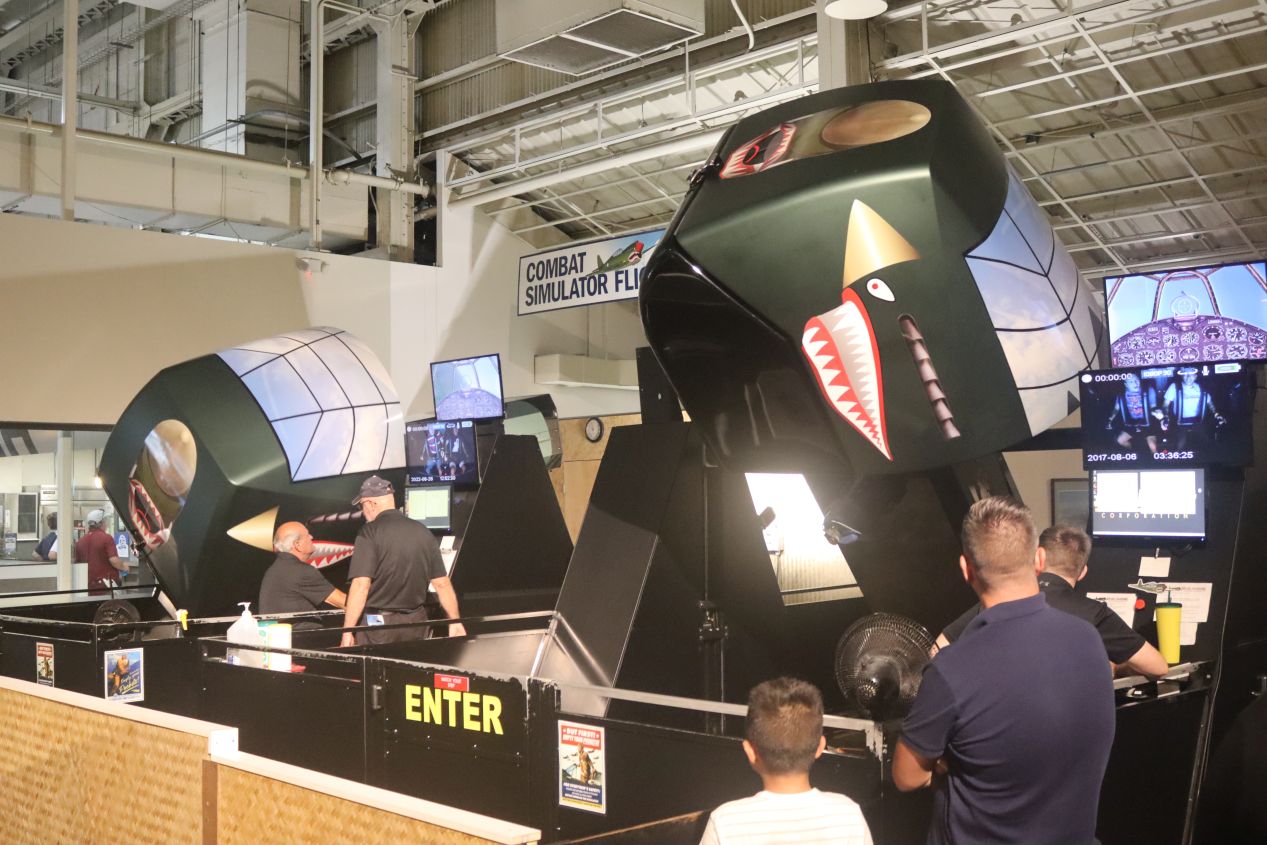


Pearl Harbor Aviation Museum was reminiscent of several other museums that I've visited with large numbers of aircraft on display; I was reminded of the Udvar-Hazy branch of the National Air and Space Museum located near Dulles Airport in northern Virginia and the Museum of Flight run by Boeing outside Seattle, Washington. Most of the planes featured at the museum were American craft along with a couple of restored Japanese planes which were the same models used for the attack on Pearl Harbor (if not any of the actual planes themselves). We were also visiting at lunch time and ate a meal at the Air Force-themed Laniakea cafe which was full of 1940s-themed stuff plastered on the walls. The food on the menu was not limited to 1940s America, however, with rice bowls and plant-based meat options in addition to the expected burgers and hot dogs. The flight simulators on display were entertaining to watch other visitors test their skills but our stomachs didn't feel up to trying them ourselves.


There were more airplanes on display outside Hangar 37, a group of them sitting around outdoors along the walking path to the museum's other hangar. These were jet-based aircraft which were clearly more recent in design as compared with the propeller-based models that made up the vast majority of the airplanes during World War II. There was also a small temporary exhibit dedicated to Bob Hope, of all people, in commemoration of the innumerable shows that he performed for active-duty American soldiers around the world. These side attractions led to the other main museum space in Hangar 79:

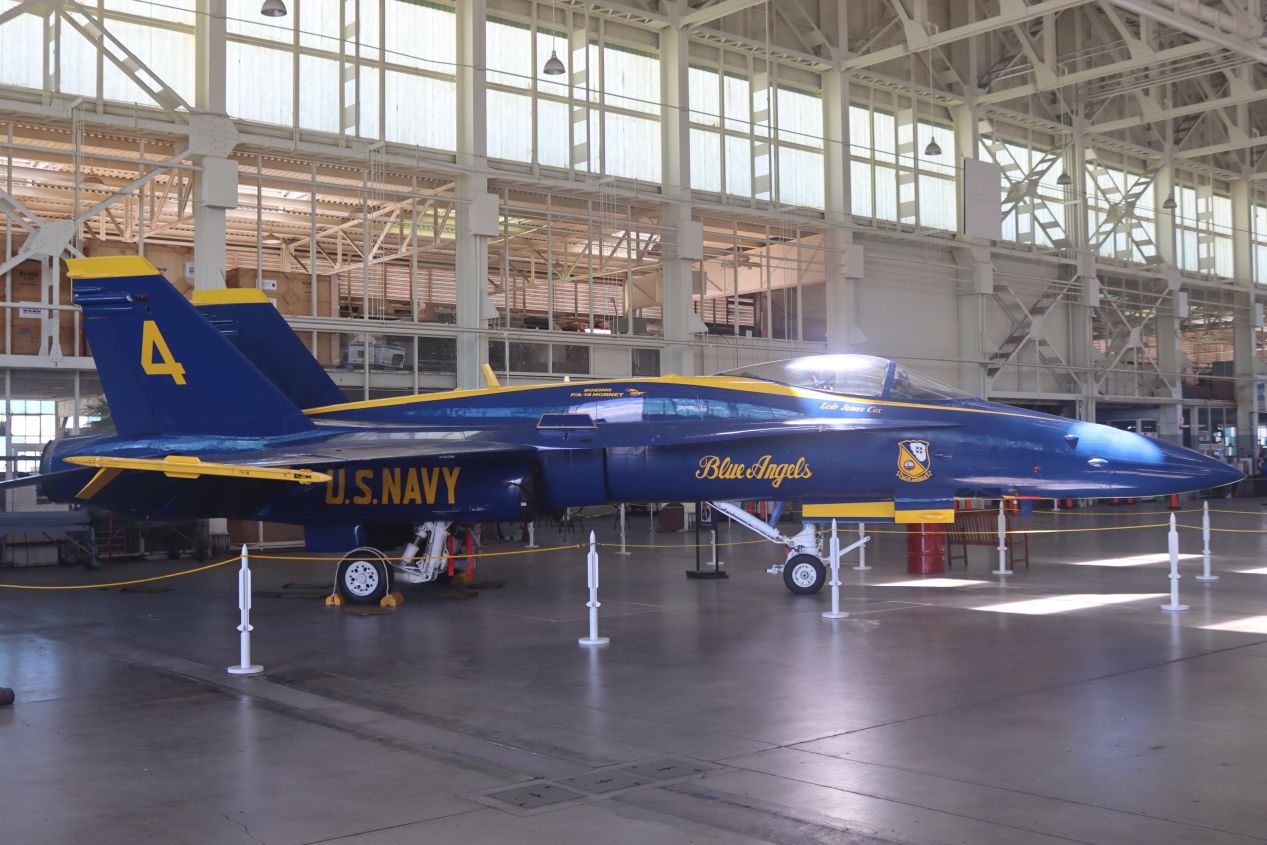


This hangar was a more recent addition to the Pearl Harbor Aviation Museum and had a less polished feel to it, lacking formal exhibits and instead simply housing more aircraft that the museum wanted to put on display. Some of the airplanes here were from World War II and some were not, with more recent planes such as the Blue Angels jet looking vastly sleeker and deadlier than its earlier forerunners. My favorite plane in the whole museum was located here, the "Swamp Ghost" B-17 bomber which was shot down over Papua New Guinea in 1942. The crew of the plane made a controlled crash landing and put it down in a swamp, then marched hundreds of miles overland until they could be rescued by Australian soldiers. As for the Swamp Ghost itself, its wreckage sat partially buried in a marsh for six decades and was used by pilots as a local navigational aid before finally being recovered in 2006 and brought back to the United States for repair. Hangar 79 also contained windows with bullet holes in the glass that dated back to the Japanese attack in 1941 (although some of those holes were likely due to friendly fire). The air field deliberately left the windows unrepaired as a reminder of the attack and of those who lost their lives.

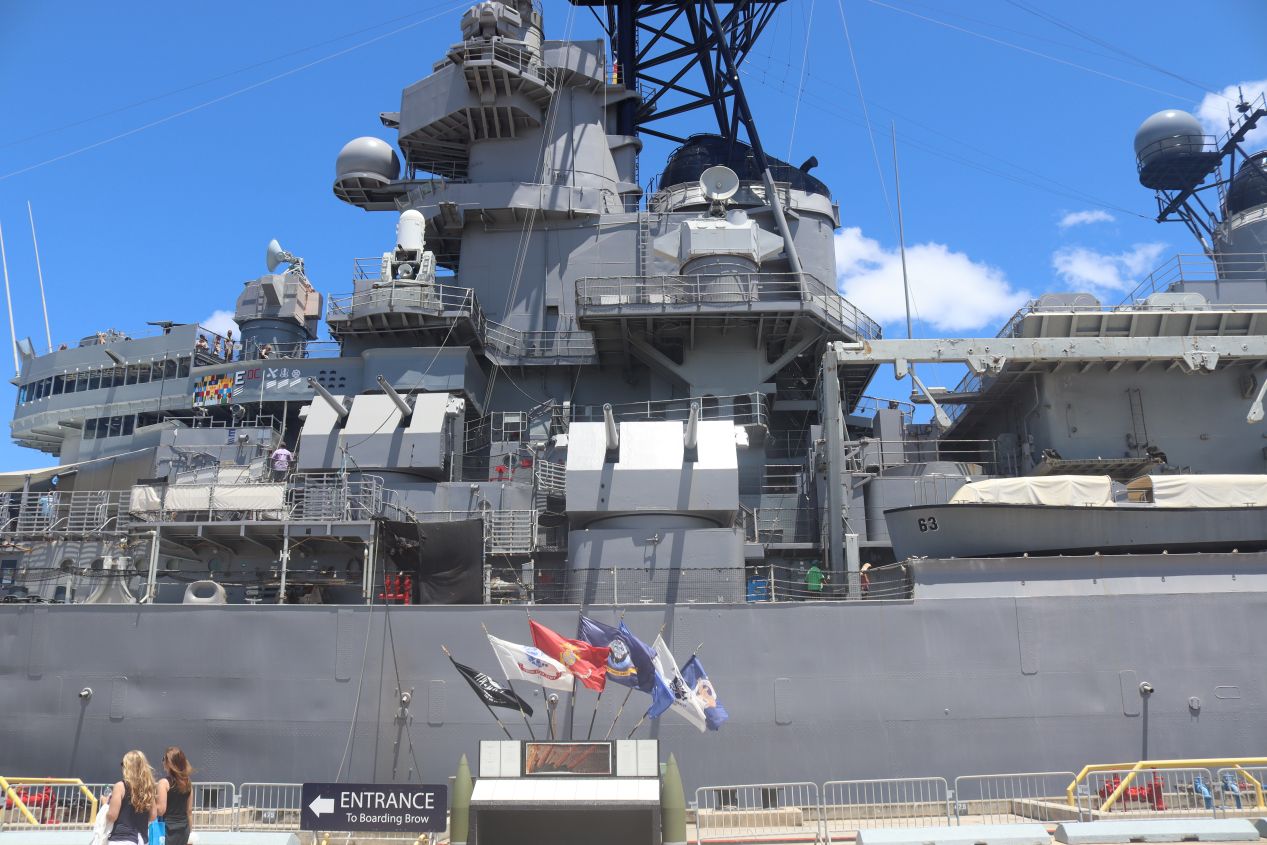


We had one more attraction to visit before departing Pearl Harbor for the day, the nearby USS Missouri Museum. This battleship is also located on Ford Island and reached via the same shuttle bus service used by the aviation museum; the shuttle bus actually stops initially at the USS Missouri so we had to go back to the visitors center and get on a second bus to make our way over to the humongous battleship. The Missouri was impossible to miss as it towered over everything in its vicinity, standing an eternal watch over the USS Arizona Memorial several hundred feet away in the direction of its bow. Before we boarded the ship itself, I walked down to the end of the pier where it was docked to capture the size of the Missouri as it stretched away into the distance. The Missouri had an official length of 887 feet / 270 meters and held just shy of 2000 navy personnel when it was fully complemented. This was the last battleship ever commissioned by the United States and it saw action during World War II and the Korean War, if not the ship-to-ship action for which it was originally intended. (Battleships were mostly used for shelling ground targets after it was discovered that carrier-based aircraft were more useful than big-gun battleships for pretty much everything.)

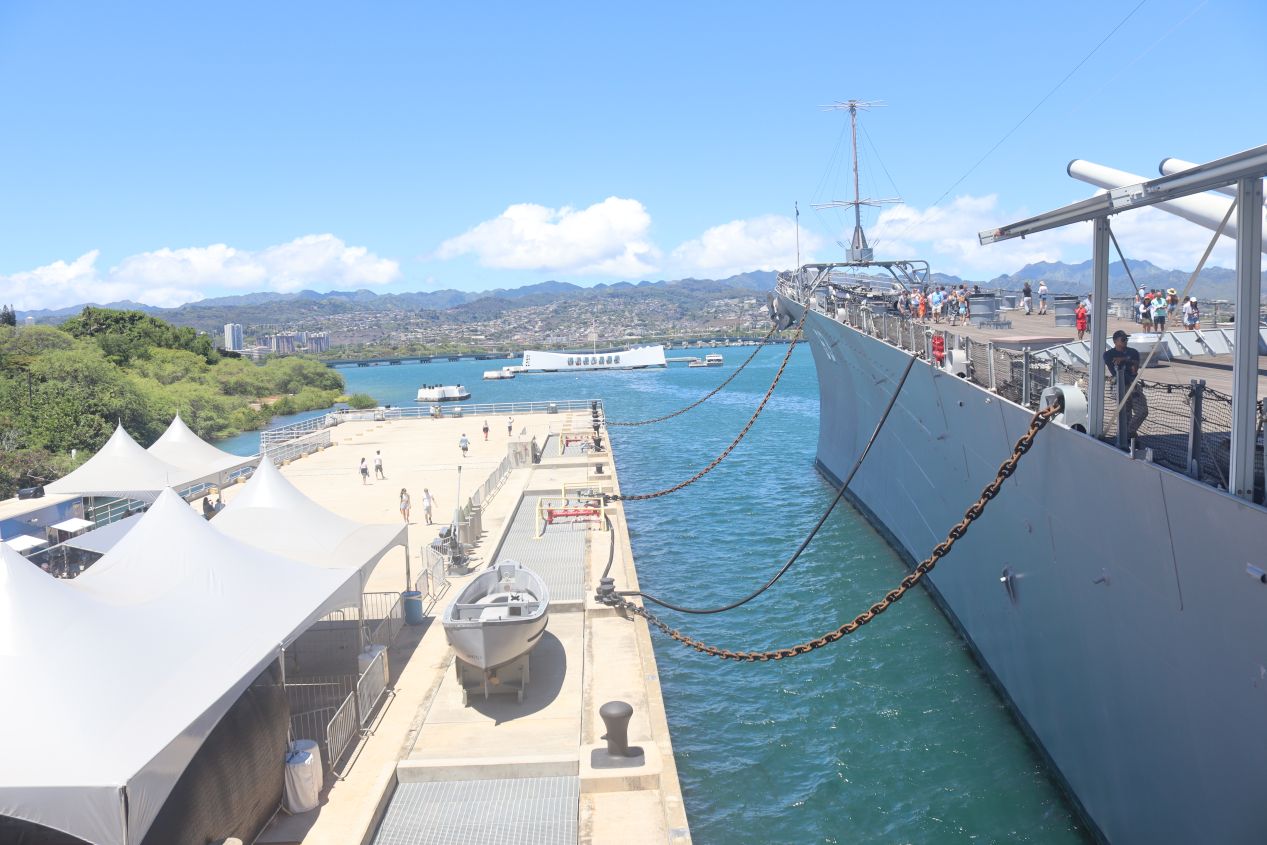


The USS Missouri was therefore kind of a lumbering dinosaur, commissioned in 1941 and already outdated in military terms by the time that it was launched into the water in 1944. It was carriers and the aircraft that they held which determined the outcome of the war in the Pacific, not battleships, and smaller destroyers and cruisers could protect the all-important carriers as well or better than battleships. Nevertheless, there's a certain romanticism and public fascination with battleships that their smaller cousins lack based on sheer scale of size. We started out by exploring the main deck at the bow of the ship and it was hard not to be impressed by the massive scale of the main gun turrets. The Missouri's primary armaments consisted of three different triple 16 inch / 404 millimeter guns that could throw a shell weighing 2200 pounds / 1000 kilos up to 24 miles / 38 kilometers away. Some of the earliest computers were developed specifically to do the calculations associated with firing the enormous guns on battleships since the distances were so far that the effects of gravity and the curvature of the earth had to be factored into the numbers. These may have been impractical weapons once modern aircraft were developed but they certainly were gigantic to see up close.

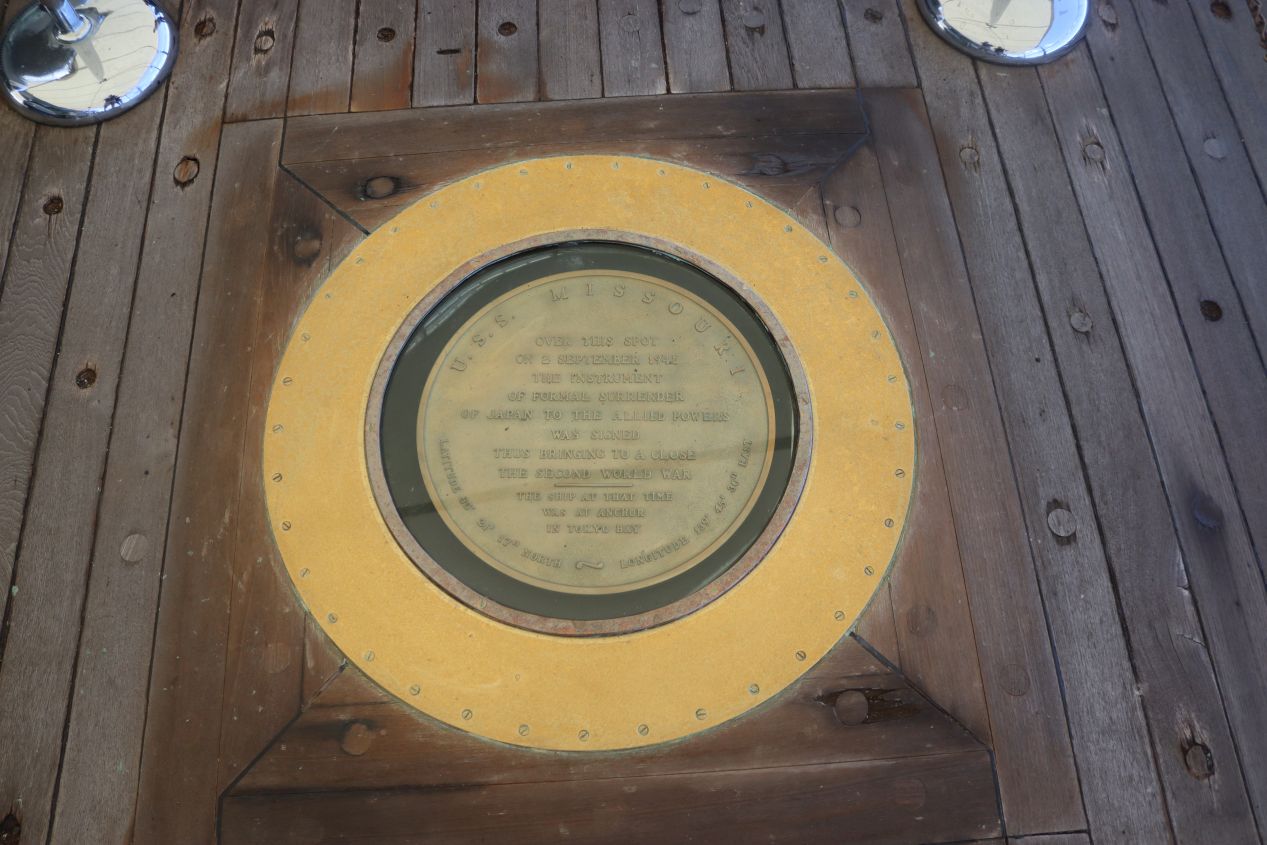


The Missouri is most famous for serving as the location of the formal Japanese surrender at the end of World War II. The ceremony took place on a raised portion of the main deck and there are several signs along with a roped off marker to indicate where the treaty signing took place. The Missouri was located in Tokyo Bay at the time and the short ceremony occurred during the morning of 2 September 1945. There's a replica version of the signed treaty on display at the Missouri which amusingly preserves the error made by the Canadian representative who signed on the wrong line and forced everyone else below him to cross out the printed text and hastily scrawl in the corrected names. I can only imagine his embarassment: imagine being present at a historic ceremony like this and then accidentally signing your name in the wrong place!  History is full of fun tidbits like this that often get overlooked.
History is full of fun tidbits like this that often get overlooked.

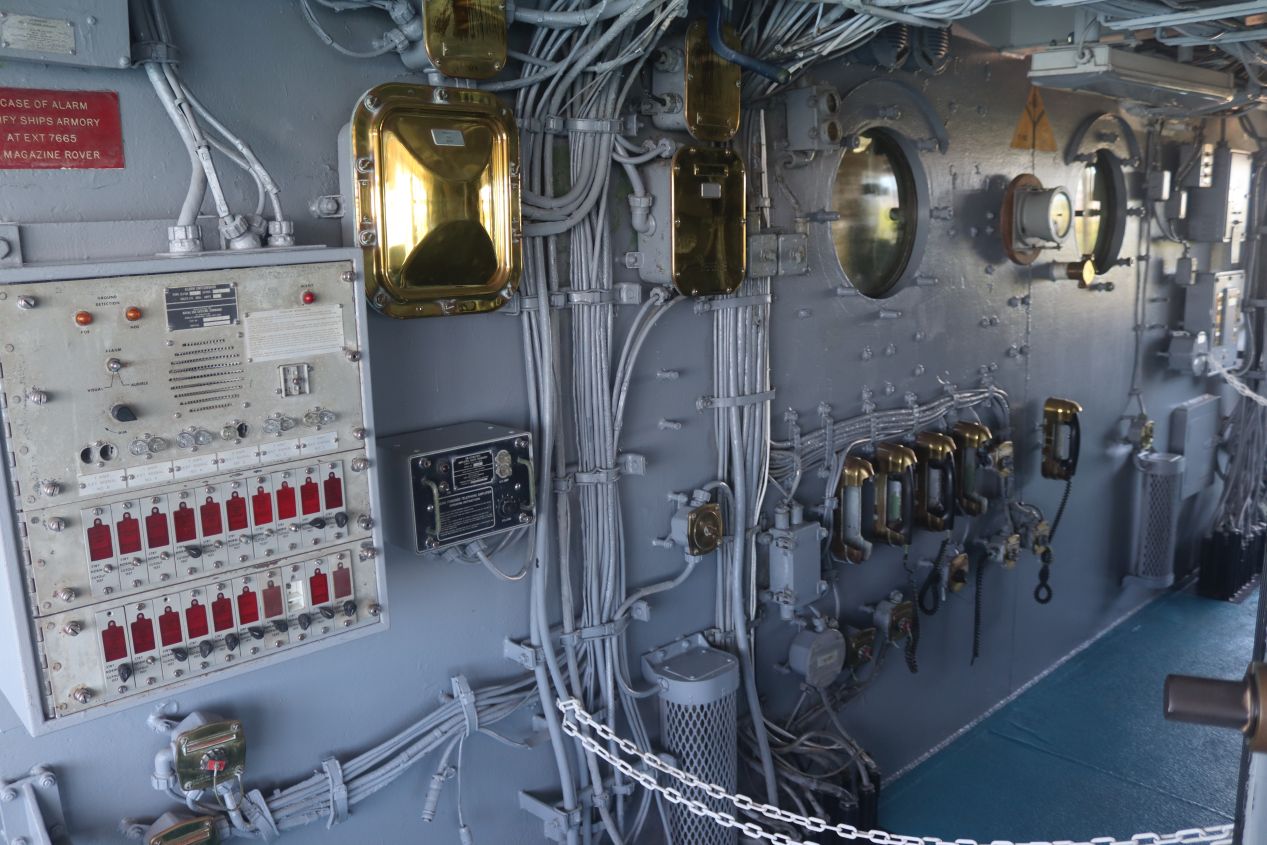


We were able to tour the bridge of the Missouri which involved climbing a series of steep ladders up to the command and control portion of the vessel. I was surprised to find that the actual helm of the ship where the steering wheel was located (captured in the first picture above) did not have any direct view of the ship's exterior. This was deliberately done to encase the helm with as much thick armor as possible for protection against incoming shells. The actual steering required constant communication with other parts of the bridge that had an unobstructed view and coordinating with the ship's radar systems for safety. As expected for a ship built in the pre-computers age, there were big metal switches and dials and knobs everywhere that must have had all sorts of mechanical functions. Afterwards we walked back to the stern of the ship which held the third main gun turret along with an open part of the deck that had been converted into an outdoor seating area with a podium for giving speeches. This was the part of the Missouri where a kamikaze attack hit the hull in April 1945 but failed to punch through the armored plating. There was a small placard commemorating the event and a note that the crew held a ceremony for the enemy pilot in recognition of his bravery.

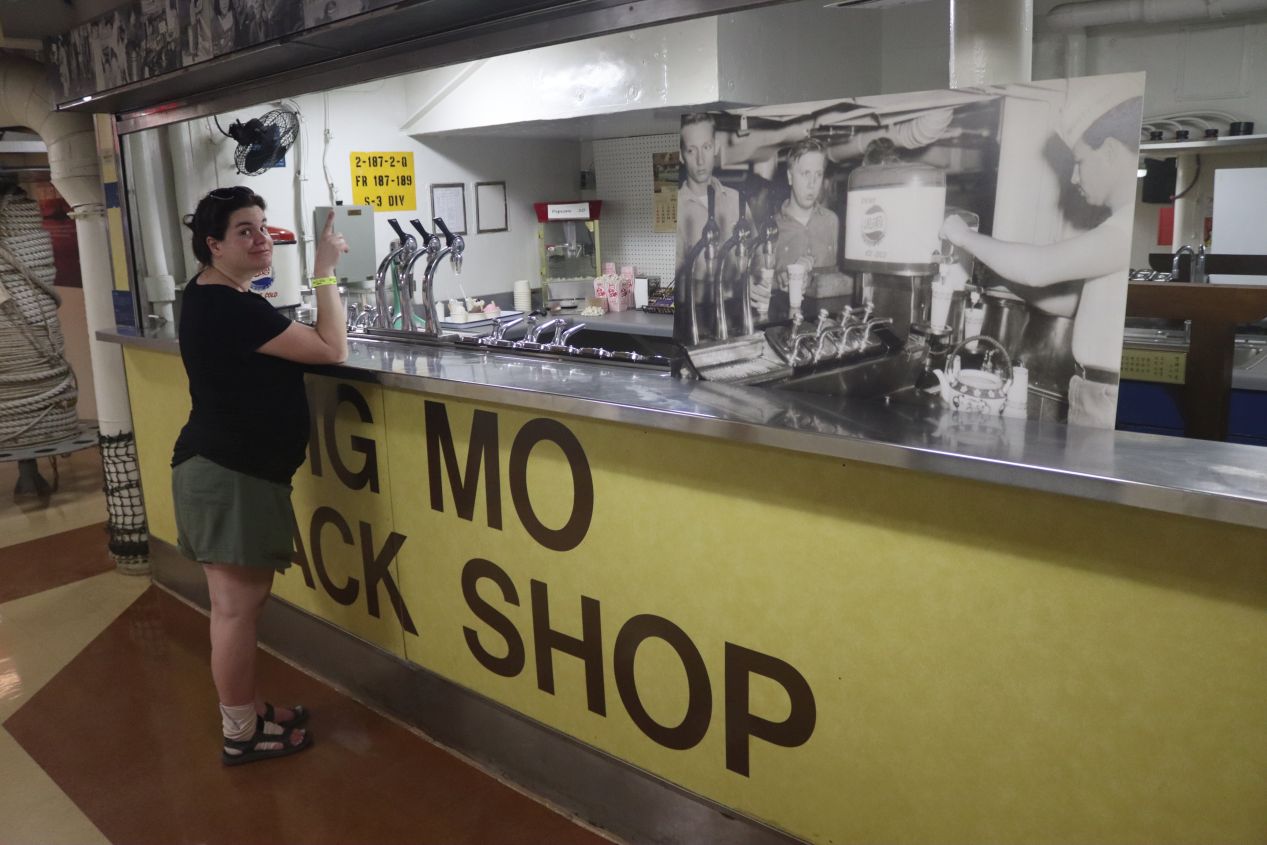


We also had the opportunity to tour the interior of the ship, or at least one of the upper decks where many of the Missouri's important systems were housed. Entry required climbing down a steep ladder towards the stern of the ship followed by what felt like miles of corridors stretching in every direction as they wound through an internal labyrinth of steel and concrete. There was a library down here along with the "Big Mo Snack Shop" where off duty crewmembers could purchase something to eat outside of official meals. Speaking of food, we were able to see the strictly regimented dining facilities on board the ship, ranging from the officer's meal quarters to the one used by chief petty officers to the cafeteria-style mess haul for the enlisted men. The military is not a democracy and everyone is well aware that the officers get much better living quarters than the rank and file sailors.

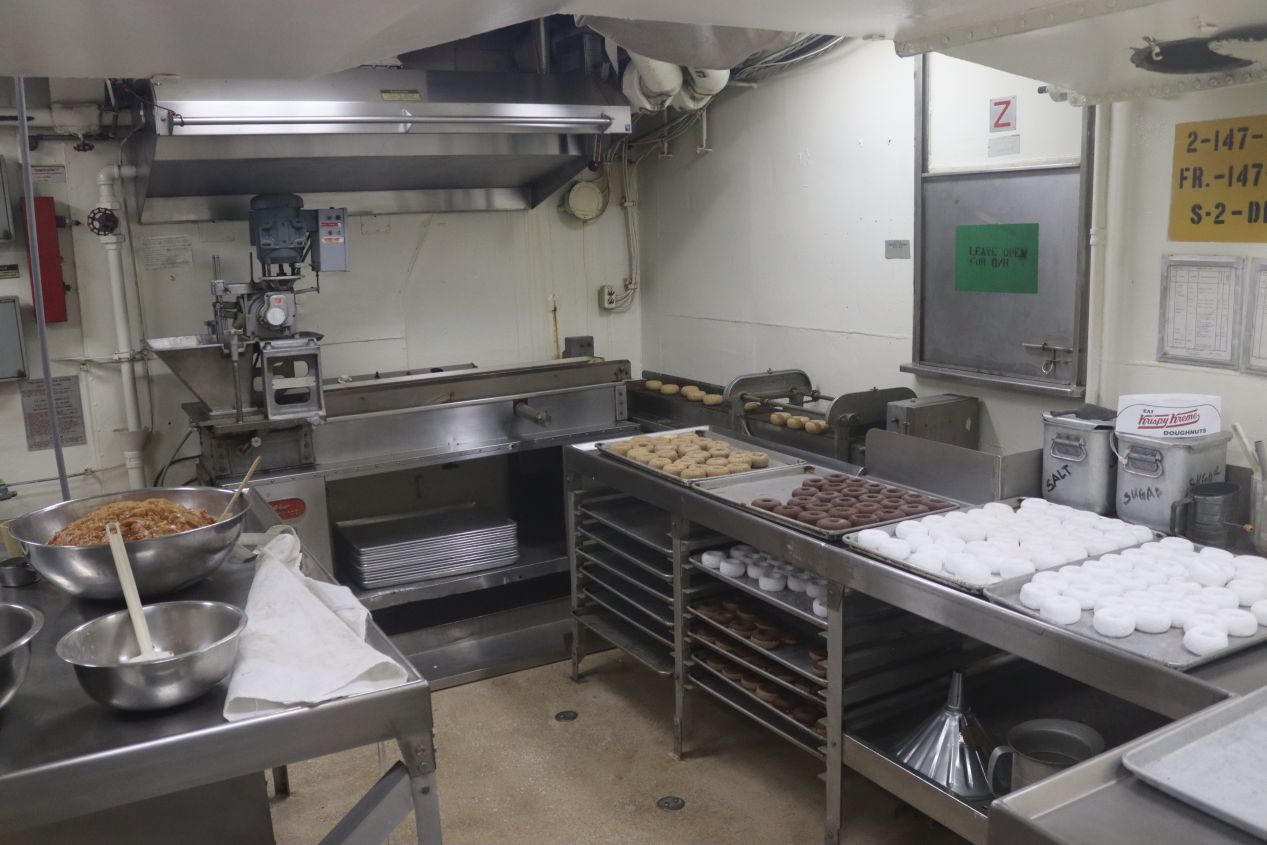


The huge kitchens where the food was prepared each day were another one of the more interesting parts of the walking tour through the ship's interior. The Missouri contained a bakery and a pastry shop in addition to its main kitchen and the food options on the preserved menus looked pretty decent all things considered. (Whether the menu options were always this robust is a good question.) We also walked past a small sample of the claustrophobically-small living quarters for the enlisted men which consisted of little more than a bunk bed and a truly miniscule locker. There was next to nothing in the way of privacy for these sailors and trying to sleep in turbulent weather while crammed into these bunks like sardines in a can had to have been a truly miserable experience. The Missouri held 1804 enlisted men along with 117 officers when it was fully outfitted, and short of serving on a submarine it was hard to find a place where space was at more of premium.

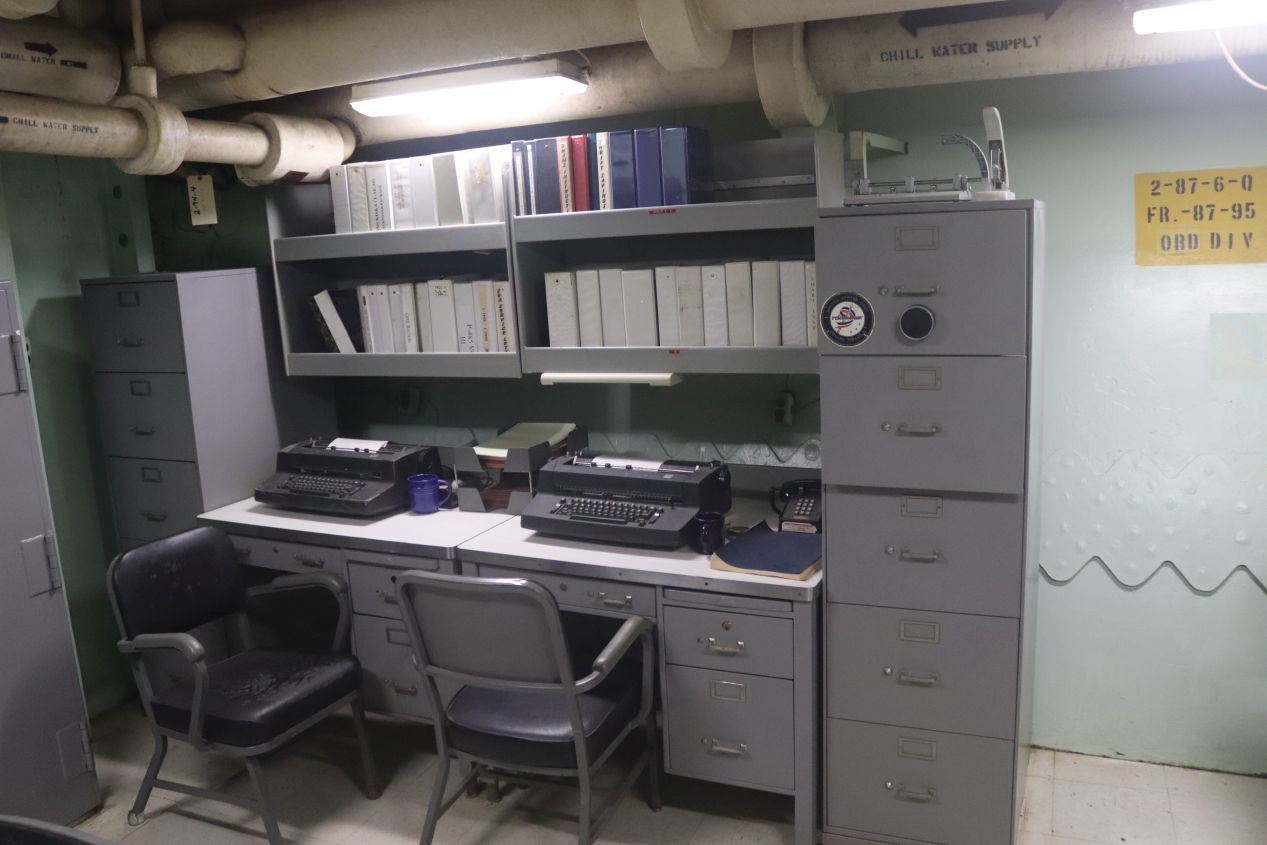


The Missouri was deactivated from service in the 1950s after seeing action during the Korean War and spent the next three decades docked as a floating tourist attraction near Seattle. That changed in 1984 when the ship was reactivated as part of President Ronald Reagan's iniative to return to a 600 ship navy during this flare-up in the Cold War. Now did it make any real sense to bring the Missouri back into active service again in the 1980s given that it had already been outdated from a naval doctrine perspective forty years earlier? Most certainly not but Reagan was trying to drum up patriotic support for his reelection campaign, and it worked in spades as he won 49 states while coasting to victory over poor Walter Mondale. As for the USS Missouri, it went through a process of refitting and returned back to active service again, seeing action as a support vessel in the Gulf War during 1990-1991 before the Clinton administration sensibly decommissioned it for good in 1992. Thus visitors to the Missouri experience a ship that's frozen in time with everything dating from the late 1980s / early 1990s. There are typewriters everywhere along with computers in a lab that were cutting-edge in 1992 and adorably outdated today. There are a bunch of notes and daily orders with date stamps from 1992 and it's a little bit eerie to see everything preserved at this one moment in history as if the passage of time somehow stopped.
Anyway, that was everything that there was to see at the USS Missouri Museum. We rode the shuttle bus back to the main visitor center as it was beginning to shut down for the day, then caught another ride share back to Waikiki where we had dinner for the evening. We were still adjusting to the local Hawaiian time and were already feeling tired by 9:00 PM and therefore didn't try to stay out late. The next day would be dedicated to exploring the nearby sights in Waikiki in more detail and hitting the beach for the first time.



